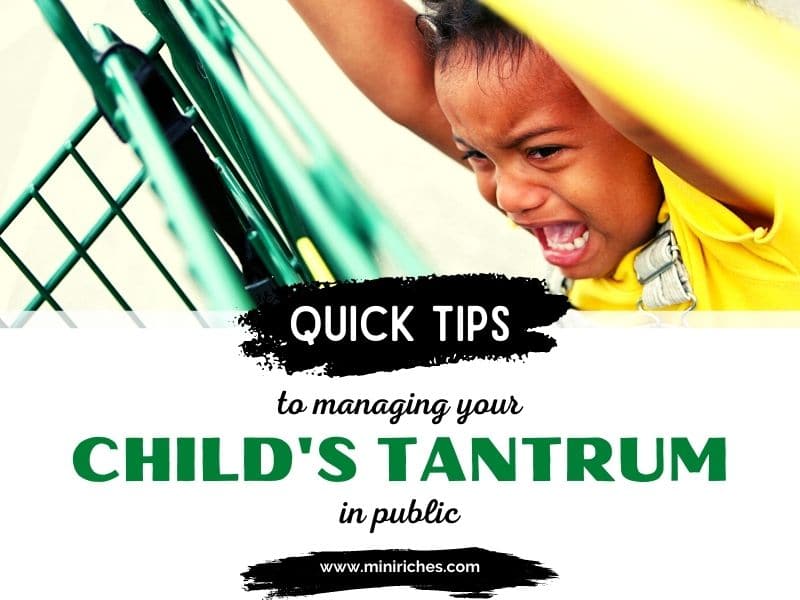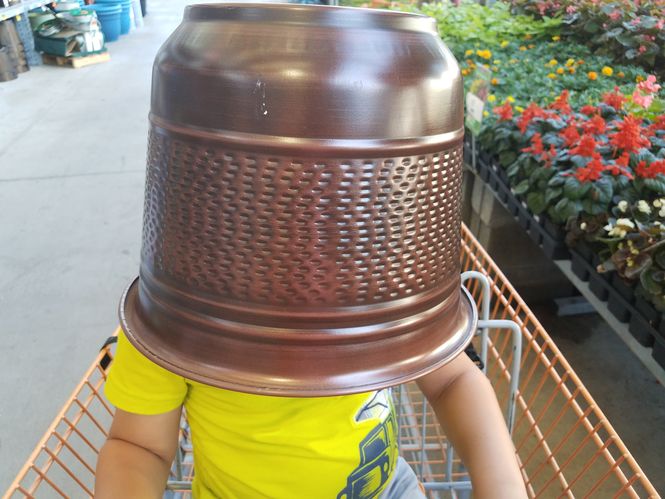
8 Quick Tips to Managing Your Child’s Temper Tantrum in Public
We’ve all been there. Rolling down an aisle at the store or sitting in church, and then it begins.
Your child starts to act out.
You hear, “Mom! I want the cereal with the tiger on it!” or “I want to go home!” or some other variation of that in a whiney scream. You can’t say or give them what they want because bad behavior deserves no rewards. Of course, any opposition from you will trigger an avalanche of volcanic emotions and leaves you left to handle your child’s temper tantrum in public.
What is a child’s temper tantrum?

A child’s tantrum is an explosion of frustration, anger, and bad behavior—such as crying, screaming, flailing around, becoming aggressive, and running away. Tantrums are the child’s inability to regulate their emotions in situations where they don’t get the outcome they expect—like when you tell them no for any reason whatsoever.
There’s no guarantee that you can dodge every one of your child’s temper tantrums in public, but that doesn’t mean you shouldn’t try! Here are a few tips I’ve found through the years to help avoid my child’s temper tantrum in public altogether.
Tips to help prevent my child’s temper tantrum in public:
- Pack snacks and a sippy
- Bring travel-friendly toys
- Learn your child’s triggers
- Go over expectations
1. What do I mean by pack snacks and a sippy?
Does your child have a favorite snack or two that travels well? If they do, then forgo giving this snack while at home. Instead, save it for when you all have to run errands together. As always, with small children, have their sippy cup ready to go too!
My children love fruit snacks! For this reason (and because I want to save their teeth), I don’t give them fruit snacks at home. I instead save them for outings, which makes them a special snack—one worth good behavior! I hand them out after we arrive at our destination, and it puts my kids in a good mood even when stuck in a shopping cart or patiently waiting for an appointment.
2. Always bring travel-friendly toys.
I love crayons, but you will spend so much time picking them up off of the dirty floor if you bring them along on an errand. Instead, bring a more compact activity like an Etch a Sketch or an invisible ink coloring pad that reveals the color using only one clear marker (maybe that last one is more for me!). An action figure for each little hand or board book your child hasn’t read in a while are also errand-friendly toys that may help prevent a child’s temper tantrum in public. Also, be fun! Anything that can be considered fun while keeping their attention is a plus.

I try extremely hard to steer clear of using electronics to entertain my children while out running errands. I want to teach our kids to be aware of their surroundings and how to act appropriately in them. They won’t learn how to be aware of their surroundings if they are staring at a screen the entire time. Staring at a screen can also encourage your child’s temper tantrum in public should the device fail to operate correctly for any reason. Phone charger, anyone?
3. Learning the triggers can help stop your child’s temper tantrum in public.
If your child has thrown fits in public before, take some time and figure out what caused them. Then come up with a plan to prevent it next time around.
If strolling by the toy aisle caused a major meltdown, save that side of the store for last. If your child was hungry or tired before heading out the door, try to plan your errands for after nap time or for the early morning so your child is fed and well-rested. Part of having a well-rested child is making sure they receive the amount of sleep they need.
4. Go over expectations well beforehand.
Talk with your child before leaving the house and again before entering a public place. Make it short and sweet, but tell your child what you’ll be doing while at that place and review your expectations for their behavior.
Going over expectations might be a little more difficult for children younger than three years old but do it anyway. Children can catch on quickly. I’ve found through the years that one of my greatest mistakes was to undervalue my child’s abilities and give them a free pass to misbehave.
Prevention can make a world of difference in you and your children’s lives. Lowering your stress level is worth the minimal extra effort to skip the stress of a child’s temper tantrum in public.
When our little people are overwhelmed by big emotions, it’s our job to share our calm, not join their chaos.
—L.R. Knost
But the fact remains, you will eventually face your child’s temper tantrum in public. When that day comes, here are a few strategies you can use to help diffuse the situation.
My favorite strategies in handling my child’s temper tantrum in public:
- Take a deep breath and assess the situation
- Get your child’s attention
- Redirect, or solve the problem
- Let them feel it and love on your child
5. Take a deep breath for two and assess the situation.
Your child’s temper tantrum in public can set off a chain reaction of your own emotions. Once they explode, it’s like a mini volcano erupts inside of you as well. Take that deep breath, calm your internal volcano, assess what is actually going on around you, and assess your child.
Are you in a crowded space that you should leave before addressing your child’s behavior? What triggered the tantrum? Is there a quick fix, like picking their toy up off the ground, or will the situation need a more focused response?
Quickly assess the situation around you and decide how to move forward in diffusing your current situation.
6. Get your child’s attention.
Your child is wrapped up heavy in their tornado of emotions at this point—simply saying their name often won’t cut it. I like to get their attention by touch. Either by scooping them up, placing my hands on their shoulders, holding their hands, or brushing my hand through their hair. I aim for my touch to be loving, but also to be a way I can grab hold of my child if he decides to throw himself on the floor or do something else that could possibly hurt him more.
Saying outlandish and funny things may also grab your child’s attention. Some examples I’ve used in the past include:
“Wow, did you see that bird fly across the ceiling!”
and
“This watermelon is as big as your head!”
Now that you’ve got their attention, move on to redirecting or solving the problem.
7. Redirect or solve the problem.

Some tantrums can be fixed quite quickly once you know the problem. For us, it’s typical that one child will ride on the front of the shopping cart. If that child gets off, another one will jump on, and then the first child throws a fit because their sibling stole their spot! The quick fix would be to explain to the first child that they got off, so another child is allowed to get on. Or, let your child know they can ride for five more minutes, and then their sibling gets a turn.
Sometimes it is as simple as asking your child what’s the matter, but sometimes it’s not.
If your child’s public display of displeasure is much more out of control or a problem you can’t fix—like when they want sour gummy candy, and you have to say no—then I suggest redirection. Move from the area you are into a more neutral place with fewer distractions. If you can’t change scenery, have your child regain focus on you and not the world around him. Address their feelings, what they want, and provide an alternate solution. Here are a couple of examples of redirections I’ve used in the past:
“I know you want sour gummy candy, and you’re upset because mommy is not buying that today. How about you help me by pushing the buggy?”
and
“Would you like to play with the toy you brought?”
Give your child the attention they need in the moment so that you can all better proceed with the task at hand.
8. Most importantly, love your child and let them feel their emotions.

When your child calms down and regains control of themselves, praise him. Tell him you are proud that he could regain control, listen to mom (or dad), and choose good behavior. Hugs, kisses, and even a special job are also appropriate ways to reward your child for their success in calming down.
Rewarding your child for calming down on their own is not the same as rewarding your child for their tantrum. If you use phrases like “You can have the candy if you quit crying,” then you are rewarding the tantrum and not the choice to regain control. Your child will continue to use bad behavior to get what they want because you rewarded lousy behavior last time. If you can get your child to willfully calm down, with the knowledge that throwing tantrums in public is not acceptable behavior, then you can praise and reward him.
What to do when nothing works.
You gave it your best shot. You tried to get your child’s attention, solve the problem, redirect, and leave the scene of the tantrum. You even broke the rules and tried to bribe the good behavior out of him with no success.
It’s ok if your child’s temper tantrum in public takes a while to calm down. There’s something to be said about being comfortable while in an uncomfortable situation.
Don’t be embarrassed!
It’s ok to feel deeply. It’s ok to let your child feel what they’re feeling, even if you are in public. Their emotional development will thank you later. This situation doesn’t need to suck.
My final thoughts on my child’s temper tantrum in public.
It doesn’t matter if you’re a new parent, a seasoned parent, or a grandparent—managing a child’s temper tantrum in public surely isn’t on your list of things to do for a good time. Don’t worry about what others around you may think. Remember, it’s ok to appreciate the rawness of a new soul and to love your child unconditionally. Just don’t forget to grab the macaroni and cheese on your way out!
Are you familiar with temper tantrums? What tips do you have to handle a child’s temper tantrum in public effectively? Let us know in the comments below!
On a side note, if you’re dealing with a child’s temper tantrum at home and it involves another sibling, some consequences may be in order. Check out What To Do When Young Siblings Fight and Argue for solutions to different quarreling sibling scenarios.
